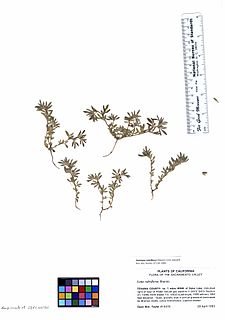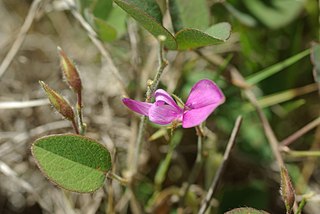
Lasthenia burkei is a rare species of flowering plant in the family Asteraceae known by the common names Burke's goldfields and Burke's baeria.

Ivesia webberi is a species of flowering plant in the rose family known by the common names wire mousetail and Webber's ivesia. It is native to the United States, where it occurs in the northernmost part of the Sierra Nevada and the adjacent Modoc Plateau in California, its range extending just into Nevada.
Chorizanthe blakleyi is a rare species of flowering plant in the buckwheat family known by the common name Blakley's spineflower. It is endemic to the Sierra Madre Mountains of Santa Barbara County, California, where it is known from only eight occurrences, four of which are within the bounds of the Los Padres National Forest. It grows only on north-facing slopes in chaparral and woodland habitat. This plant grows upright to no more than 15 centimeters tall. It is yellow-green and hairy, with a few basal leaves up to about 2 centimeters long. The inflorescence contains several flowers, each surrounded by a tube of six hairy bracts with straight or hooked awns. The flower is a few millimeters wide with white or pink deeply notched tepals.
Chorizanthe polygonoides is a species of flowering plant in the buckwheat family known by the common name knotweed spineflower. It is native to California and Baja California, where it grows widely scattered in many types of habitat. It is a petite plant taking a prostrate form with stems just a few centimeters long at maximum. It may be green to red in color and is hairy in texture. The leaves are no more than a centimeter long and the flower is under two millimeters wide. The minute flower is surrounded by three hairy point-tipped bracts.
Chorizanthe rectispina is a species of flowering plant in the buckwheat family known by the common names prickly spineflower and straight-awned spineflower. It is endemic to California, where it is known from about twenty occurrences from Monterey to Santa Barbara Counties. It grows in dry habitat types such as chaparral and woodland in the hills of the Central Coast Ranges. It is a low, spreading plant with stems up to about 25 centimeters long, grayish to greenish in color and hairy in texture. The inflorescence is a cluster of flowers, each flower surrounded by six hairy bracts which are grayish to pink in color and tipped with awns. One bract is longer than the others and has a straight awn, and the other smaller bracts may have hooked awns. The tiny flower at the center of the bract array is a few millimeters wide and white and yellow in color.

Acmispon rubriflorus, synonym Lotus rubriflorus, is a species of legume endemic to California. It is known by the common name red-flowered bird's-foot trefoil. It is known from only four occurrences with a disjunct distribution.

Lupinus guadalupensis is a rare species of lupine known by the common name Guadalupe Island lupine. It is known only from San Clemente Island, one of the Channel Islands of California, and Guadalupe Island off the coast of Baja California. It is a member of the coastal scrub growing alongside other island endemics and more common plants. This is an annual herb growing 20 to 60 centimeters high. Each palmate leaf is made up of 7 to 9 narrow leaflets up to 5 centimeters long and just a few millimeters wide, sometimes linear in shape. The inflorescence bears whorls of flowers each about a centimeter long and blue in color with a white banner patch which may fade pink. The fruit is a very hairy legume pod up to 6 centimeters long and about one wide. It contains 6 to 8 seeds.

Nemacladus glanduliferus is a species of flowering plant in the bellflower family known by the common name glandular threadplant. It is native to the southwestern United States and Baja California, where it grows in desert and plateau habitat. It is an annual herb producing a purplish or brownish green, branching stem up to about 25 centimeters tall. Small oval leaves occur at the base of the plant. The inflorescence is a series of zigzagging branches bearing occasional flowers on thin, erect pedicels. There is a single small bract at the base of each pedicel. The flower at the curved tip of the pedicel is just a few millimeters wide. There are five pointed sepals and five white corolla lobes, generally three in the upper lip and two in the lower.
Nemacladus gracilis is an uncommon species of flowering plant in the bellflower family known by the common names slender threadplant or slender nemacladus. It is endemic to California, where it is known from the Transverse Ranges and adjacent mountains, desert, and valley territory. It can be found in rocky and sandy areas in woodland and grassland habitat. It is a small annual herb producing an upright reddish brown stem no more than about 10 centimeters long. Small lobed oval leaves under a centimeter long occur at the base of the plant. The inflorescence is a series of branches bearing occasional flowers on thin, curving pedicels. There is a single tiny bract at the base of each pedicel. The flower is only about 2 millimeters long. It has five lavender-veined white lobes fused along the lower half.
Nemacladus interior is a species of flowering plant in the bellflower family known by the common name Sierra threadplant. It is native to the Sierra Nevada of California, and it is known from Oregon as well. It grows in mountain forest habitat. It is an annual herb producing a stiff upright purple-brown stem up to about 25 centimeters tall. Small toothed oval leaves 1 to 2 centimeters long occur at the base of the plant. The inflorescence is a zigzagging series of branches bearing occasional flowers on thin pedicels. There is a single tiny bract at the base of each pedicel. The flower is a few millimeters long. It has five triangular sepals and five corolla lobes, three lobes on the upper lip and two on the lower. The corolla is white to pale purple or pink with a thin red band and yellow spot at the base of each lobe.
Nemacladus ramosissimus is a species of flowering plant in the bellflower family known by the common name smallflower threadplant. It is native to the mountains and deserts of the southern half of California and adjacent parts of Baja California. It is a small annual herb producing a thread-thin erect brown or purplish stem up to about 32 centimeters tall. Lobed oval leaves under 2 centimeters long occur at the base of the plant. The inflorescence is a series of branches bearing occasional flowers on thin, curving pedicels. There is a single small bract at the base of each pedicel. The flower is no more than 2 millimeters long with five white lobes fused along the lower half.

Nemacladus sigmoideus is a species of flowering plant in the bellflower family known by the common name sigmoid threadplant. It is native to the mountains and deserts around the intersection of California, Nevada, Arizona, and Baja California. It is a small annual herb producing a thin, spreading purplish or brown stem no more than 12 centimeters long. Hairy, sometimes toothed oval leaves up to a centimeter long occur at the base of the plant. The inflorescence is a series of zigzagging branches bearing flowers on thin pedicels which are sigmoid in shape. There is a single tiny bract at the base of each pedicel. The hairy flower is under 4 millimeters long. It has five yellow-tipped white lobes.

Perityle inyoensis, known by the common names Inyo rockdaisy and Inyo laphamia, is a rare species of flowering plant in the aster family.

Phacelia cookei is a rare species of phacelia known by the common name Cooke's phacelia. It is endemic to Siskiyou County, California, where it is known from just a few occurrences in the forest and scrub around Mount Shasta. The substrate in the area is sandy, ashy volcanic soil.

Potentilla cristae is a rare species of cinquefoil known by the common name crested cinquefoil. It is endemic to the Klamath Mountains of far northern California, where it is known from a few occurrences in the subalpine and alpine climates of the high mountain ridges. It grows in talus and moist rocky or gravelly serpentine soils. This is a low, matted plant producing a clump of hairy, glandular herbage up to about 20 centimeters tall. Each hairy leaf is divided into three rounded leaflets which are toothed or lobed and measure up to 2 centimeters in length. The inflorescence is a cyme of a few flowers, each with five small yellow petals. The fruit is a minute achene just a millimeter wide, which is smooth with a crest.

Baccharis malibuensis is a rare California species of shrubs in the family Asteraceae known by the common name Malibu baccharis.
Heterotheca monarchensis is a rare species of flowering plant in the family Asteraceae known by the common names monarch goldenaster and sequoia false goldenaster. It is endemic to Fresno County, California, where it is known from only one location near Boyden Cave in the Kings River Canyon. It grows in the limestone cliffs of this Sierra Nevada river canyon, along with a few other rare local endemics. The plant was discovered in July, 1995, and described to science as a new species in 1996.
Juncus digitatus is a rare species of rush known by the common name finger rush. It is endemic to Shasta County, California, where it is known from only two occurrences near Shingletown. It occurs in spring-moist habitat such as vernal pools in sunny locations in the foothills of the southernmost Cascade Range. The plant was first collected in 1991 and described to science as a new species in 2008.

Galactia smallii is a rare species of flowering plant in the legume family known by the common name Small's milkpea. It is endemic to Florida, where it is known only from a few small patches of remaining habitat in Miami-Dade County. It is threatened by the destruction and inadequate management of its habitat. It was federally listed as an endangered species of the United States in 1985.

Nemacladus twisselmannii is a rare species of flowering plant in the bellflower family known by the common names Twisselmann's threadplant and Twisselmann's nemacladus. It is endemic to California, where it is known only from two locations in the Sierra Nevada. There is one occurrence each in Kern and Tulare Counties.












